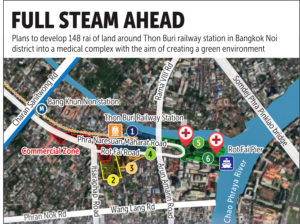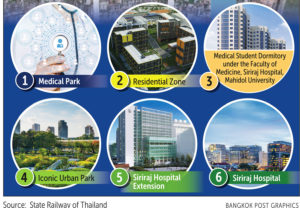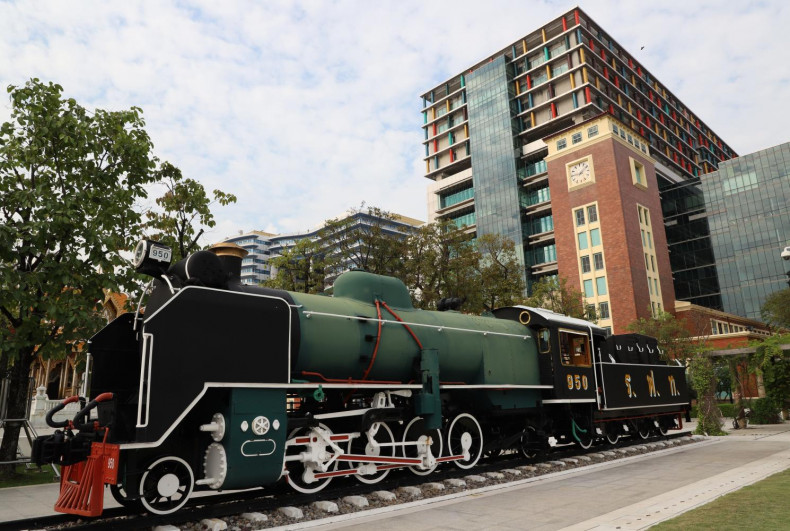
Ambitious plan for State Railway of Thailand’s land around Thon Buri railway station
Special report: Medical complex with green space and transit links to take shape
The State Railway of Thailand (SRT) plans to turn 148 rai of land around Thon Buri railway station into a medical complex with the aim of creating a green environment.
The SRT will call bids for a transit-oriented development (TOD) project, which will be the first of its kind in Thailand.
A TOD is designed to bring people, human activities, residential buildings, and public space together within walking distance of public transport.
Trithip Sivakriskul, a member of the board of directors and acting CEO of SRT Asset Co, founded to manage SRT assets and make money through various land development projects, said the company would hire a consultant to study a master plan for land development around the station.
The area under the study covers 148 rai of SRT land where the living quarters of about 300 SRT personnel and their families, the SRT’s railway maintenance and repair depot as well as a local market are located. Siriraj Hospital is also nearby.
Fit for development
The study will take six months and cost 10 million baht, Ms Trithip said, adding the development project will be divided into several phases over a period of about 20 years.
“A 14-rai plot will be earmarked for the initial stage of development, and the company will call bids this year. The plot is suited for commercial development, and several companies have expressed interest,” she said.
“The site is near the hospital and also close to the Chao Phraya River, several historic sites on the Thon Buri side as well as Rattanakosin Island on the Bangkok side,” Ms Trithip said.
“The Orange Line electric railway is also expected to open in 2026 while cabinet approval is being sought for the [Light] Red Line project.
“The Siriraj and Thon Buri stations will serve commuters using the two lines, in addition to piers and road networks in the area. This will become a major hub in the near future,” she said.
Ms Trithip said the winning bidder for the 14-rai development project could put up a condo or apartments with no more than 13 storeys as stipulated in a city ordinance issued by the Bangkok Metropolitan Administration.
“Shopping malls and retail outlets will also be built on the plot. The contractor also will be required to build new accommodation for the 300 SRT staff and their families on a three-rai plot to replace their old living quarters [which will be cleared to make way for the project],” Ms Trithip said.
After the study is finished, interested parties will discuss where the 300 SRT personnel and their families will stay temporarily while work on the building is underway.
Ms Trithip said the main idea behind the project is to turn the 148 rai into a major regional medical district set in a green environment.
On Feb 23, the company signed a memorandum of understanding with the Faculty of Medicine of Mahidol University at Siriraj Hospital to carry out a study on a master plan for development around Thon Buri railway station.
A working panel made up of various agencies will draw up the master plan.
Under the plan, connectivity and linkages will be established between road networks, walkways, and areas around the project, electric railway stations, and public transport systems. The concept of clean energy will be promoted to create a green society and environment.
 A medical complex will be put up with the collaboration of Siriraj Hospital to support development and serve as an education resource for the hospital’s medical personnel.
A medical complex will be put up with the collaboration of Siriraj Hospital to support development and serve as an education resource for the hospital’s medical personnel.
The concept of integrated mixed-use development will be promoted and implemented with residents’ quality of life taking priority, she said.
Project hailed
Dr Apichat Asavamongkolkul, dean of the Faculty of Medicine of Mahidol University at Siriraj Hospital, said the hospital is expected to start talks on a joint investment after the study is completed.
“When a format for development is determined, we expect they will invite us for talks on what area we want to co-invest in or rent from them,” Dr Apichat said. “We will need a new hospital building to take more patients as the hospital is very crowded,” he said.
 The hospital has about 17,000 staff and has to handle about 10,000 patients daily, not including relatives. On top of that, about 5,000 students study there.
The hospital has about 17,000 staff and has to handle about 10,000 patients daily, not including relatives. On top of that, about 5,000 students study there.
Dr Apichat hailed the project, saying it would benefit the public.
“While traffic congestion is heavy in the area, efficient management should help ease the traffic problem.
“For example, commuters may be encouraged to leave their cars at home and use shuttle buses to access the area, as suggested by Transport Minister Saksayam Chidchob,” Dr Apichat said.
“If each phase of the project is well managed, it will serve as a model for land development for other areas in Bangkok.
“It is important to reassure residents that the project will benefit them and any impacts will be eased,” he said, referring to SRT staff and their families.
“Those involved will have to be careful about the impacts. But when the project is complete, they should be happy as their new residential building will be near the hospital, which is also expected to be much less crowded,” Dr Apichat said.
SRT staff concern
Some SRT staff said they were concerned about where they will stay during construction.
“I’m not against progress. But they should think about this. Have they arranged a place for us to stay yet?” asked Natthawut Puanglamchiake, a 45-year-old SRT employee.
“Will they help pay the rent if we have to stay somewhere temporarily? Our children study here. I also work at a factory in the area. They should consider these matters, too,” he said.
“I also doubt how they will deal with the heavy traffic in this area, especially during rush hour. Roads in this neighbourhood are very narrow.”
Source: https://www.bangkokpost.com/thailand/special-reports/2530044/ambitious-plan-for-srt-land
